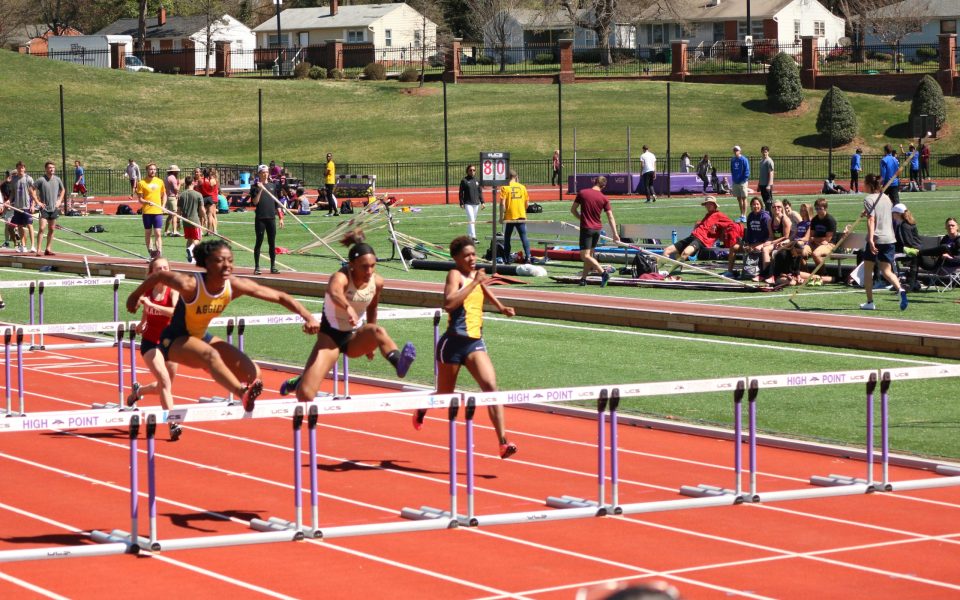Teams lounged under sun shades just outside the track. On the large field within the loop of eight lanes, pole-vaulters took informal, laid-back runs at the towering bar with few attempts to hoist themselves over it. Runners stretched and shook their limbs. The green turf shone silver in the sun.
Spectators snacked, ambling from the seats overlooking the track to the field events by the baseball diamond, then back again. They watched the athletes strive for calm as they awaited their events’ demands for complete precision.
Athletes representing dozens of universities in North Carolina and the surrounding states gathered at High Point University’s ninth annual VertKlasse Meeting on April 1 to compete in a European-style meet that featured a fast-paced sequence of track-and-field events.
Here and there, stretches of the brick-colored track exploded with sudden activity. Group by group, contestants ran their heats as the day warmed toward early afternoon: 100 meters, 400 meters, hurdles.
So much action happened simultaneously — a concentrated array of visual and auditory stimuli.
Track and field offers some of the most stunning sights in human athletics: The shocking physical contortions of the high jump, the unfathomable focus of hurdle runners, the wild intensity in the brief seconds of a shot-putter’s wind-up, the astounding movement of human muscle.
But at the VertKlasse Meeting, the sounds of the events proved equally alluring. Fans created the chatter and buzz of a baseball game, accompanied by the burst of cheer as the 15 seconds of a 100-meters race roared past. Integral to the events came each startling shot of the starting gun. The death knell of a runner’s heel hitting a hurdle, rattling the obstruction to the track, slowed the runner by precious tenths of a second, or plunged them into the hard ground and absolute defeat. Throughout the stadium, young men and women embodied the sights and sounds of the VertKlasse Meeting.
But that hasn’t always been the case.
When the stadium’s namesake competed in the mile and 2-mile events for High Point University in 1959, there was no women’s team.
Vert Stadium honors Dick and Peg Vert, two of High Point University’s greatest benefactors. (The event’s name, VertKlasse, also nods to these alum, deriving from the Weltklasse Zürich, an annual international meet in Switzerland.)
On April 1, Dick Vert himself strolled around the stadium like the other spectators, enjoying the beautiful weather, site and competition.
But looking back almost 60 years, Vert remembered the differences, beginning with even the track itself.
“It wasn’t what it is here today,” Vert said. “It was considerably older. The old-time cinders were on the track. You didn’t have the synthetic surfaces like you have today.”
Vert confirmed that the cinders hurt like hell to fall on.
But there was a greater difference than the surface on which the athletes ran.
Like many schools around the country, High Point University didn’t permit a women’s track-and-field team in Vert’s days as a student-athlete. He supports the inclusion avidly.
“What [equality] has done to women’s activities has really been outstanding,” Vert said.
In the decades since Vert’s student-athlete career came to an end, women’s involvement in track and field has inspired extended athletic pursuits. For athletes such as Ty-Liah Muse — a freshman at High Point University who recently graduated from Greensboro’s Dudley High School — participation in track and field opened doors when other athletic options weren’t favorable.
“In middle school I was not much of a runner,” said Muse, who now competes in the shotput and weight throw. “So I was like, I’m gonna try out the field events. And turns out I was good at them!”
Though some gender separation remains in track and field, Muse believes the division doesn’t dictate the greater camaraderie of athletes at the university.
“We do have a men’s and women’s team,” she explained. “But when it comes down to it, we all come together and we support each other.
“The support of your team does help,” she continued. “When I get in the circle, it’s so nerve-wracking. I get really nervous, but then once I hear my team cheer me on, I feel better, and I can get [the weight] out there.”
Muse isn’t the only High Point University Panther to find confidence and success through women’s track and field. Sophomore Keaton Case won two events at the VertKlasse Meeting, including breaking a 1500-meters record set in 2009.
Join the First Amendment Society, a membership that goes directly to funding TCB‘s newsroom.
We believe that reporting can save the world.
The TCB First Amendment Society recognizes the vital role of a free, unfettered press with a bundling of local experiences designed to build community, and unique engagements with our newsroom that will help you understand, and shape, local journalism’s critical role in uplifting the people in our cities.
All revenue goes directly into the newsroom as reporters’ salaries and freelance commissions.





Leave a Reply